Abstract
OBJECTIVE: The authors evaluated the long-term patency and outcome of patients undergoing infrainguinal reconstruction using the in situ saphenous vein. SUMMARY BACKGROUND DATA: The in situ saphenous vein bypass has demonstrated excellent patency and limb salvage rates in numerous studies. The authors previously reported their early results with these bypass procedures, and this article represents their long-term experience with 2058 in situ saphenous vein bypasses during a 20-year period. This comprises the largest series with long-term follow-up of in situ saphenous vein bypasses in the literature. METHODS: From 1975 to 1995, 3148 autogenous vein bypasses were performed at the authors' institution, of which 2058 used the saphenous vein in situ. The indication for operation was limb-threatening ischemia in 1875 of 2058 patients (91%). In 88% of patients with an intact ipsilateral saphenous vein, an in situ bypass was completed successfully. One thousand twenty-three bypasses (69%) were terminated at the infrapopliteal level. Of these bypasses, 1562 of 2058 (76%) were completed using the closed in situ technique. RESULTS: The 30-day patency rate was 96%, and the cumulative secondary patency was 91%, 81%, and 70% at 1, 5, and 10 years, respectively. Limb salvage rates using the in situ bypass were 97%, 95%, and 90% at 1, 5, and 10 years, respectively. CONCLUSION: The infrainguinal inflow source, length of bypass, specific outflow vessel, or vein diameter did not have a significant effect on immediate or long-term bypass performance. These data suggest that the in situ saphenous vein is an excellent conduit for femoropopliteal and femoral to infrageniculate bypasses for limb salvage.
Full text
PDF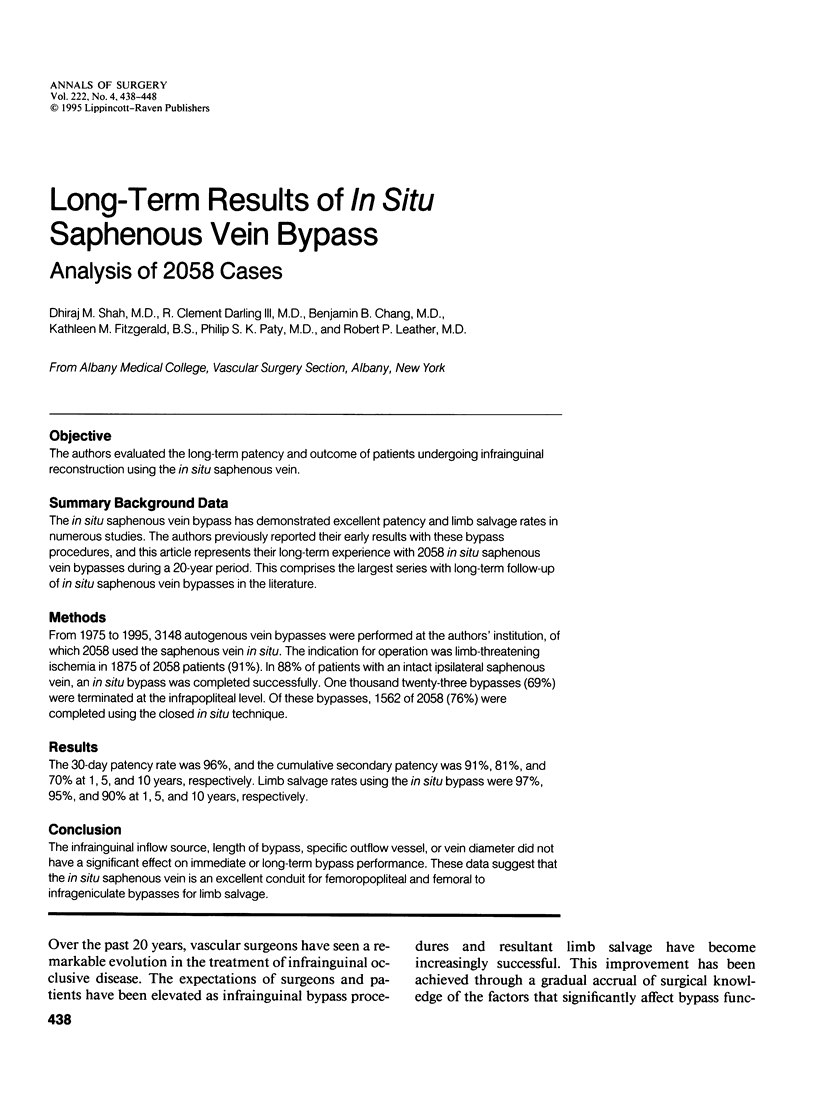
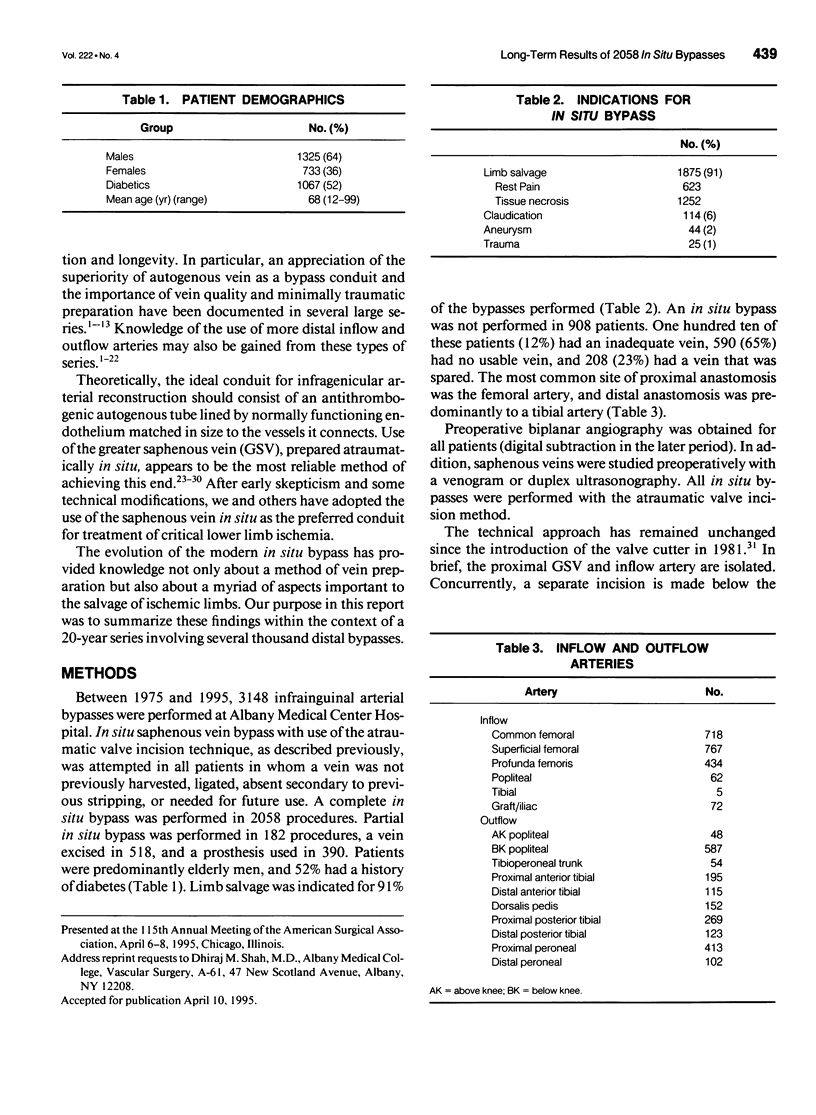

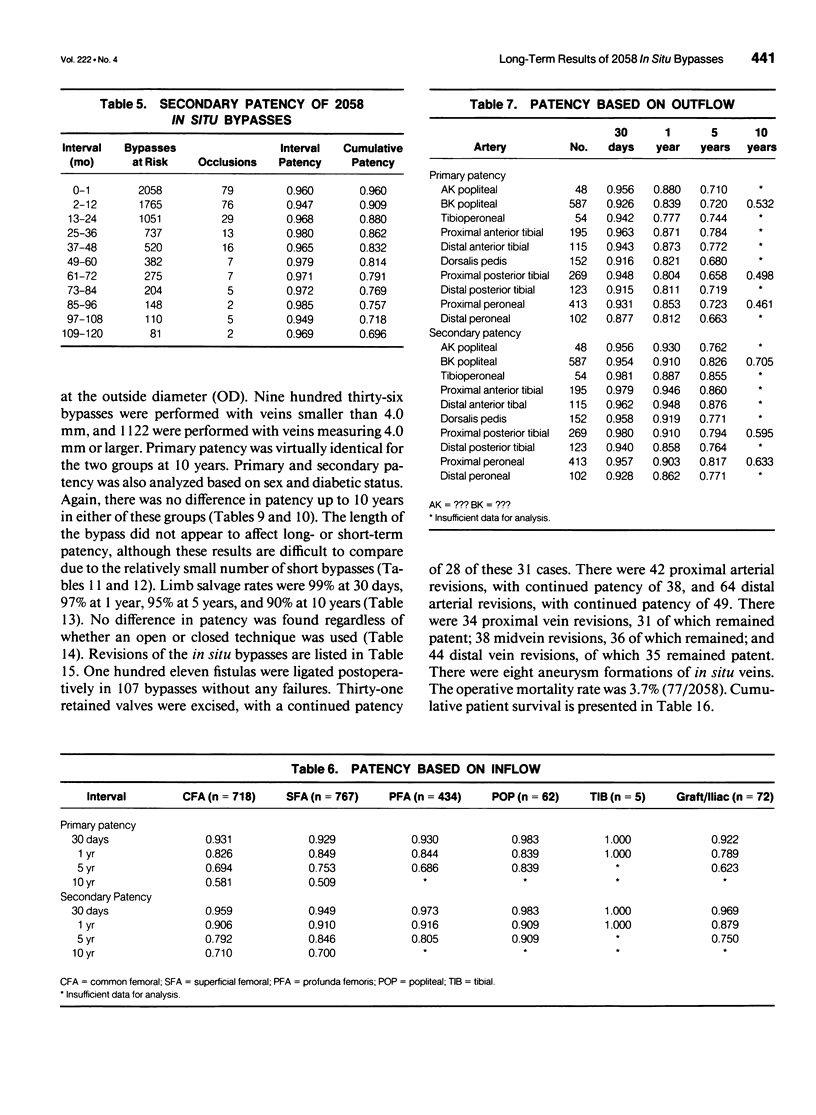
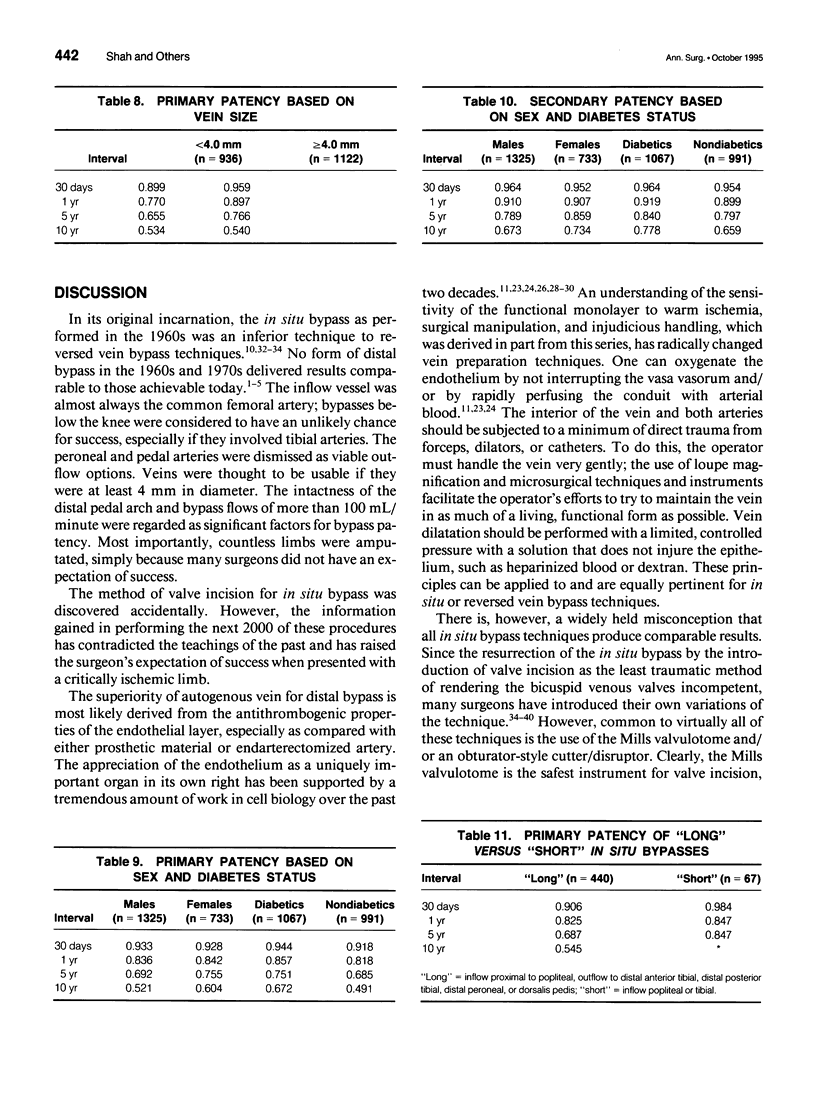
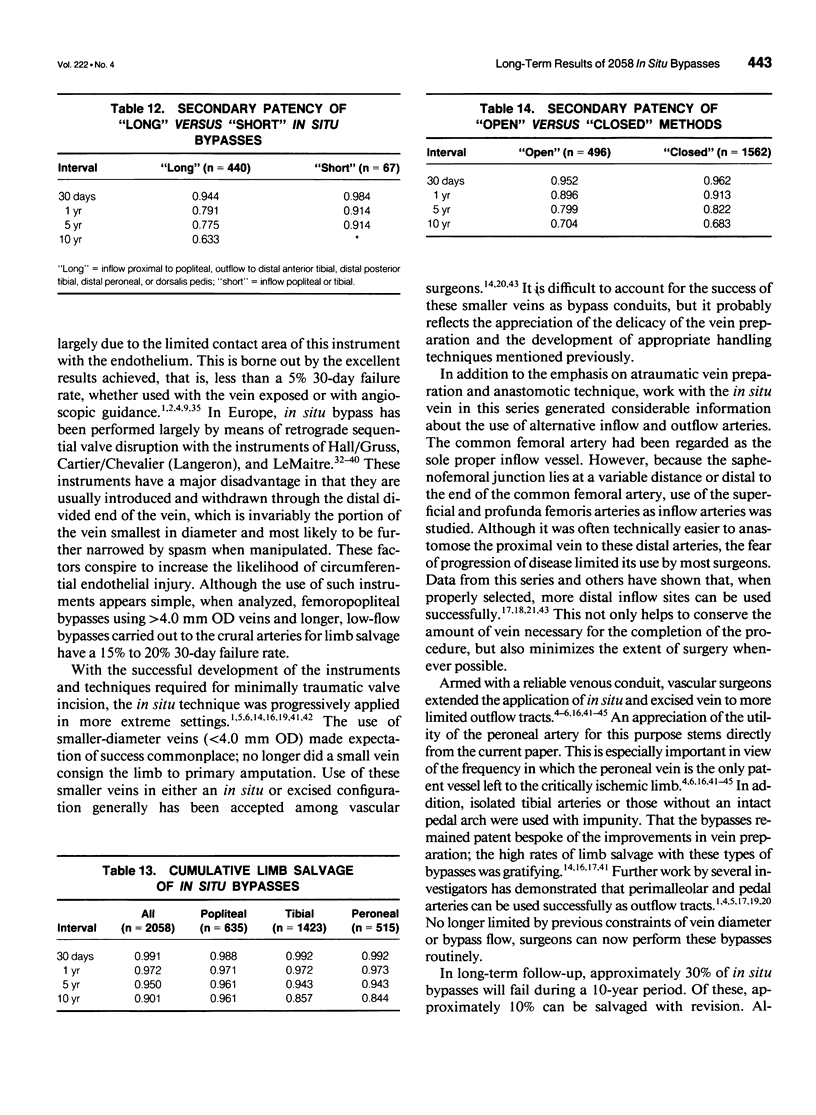
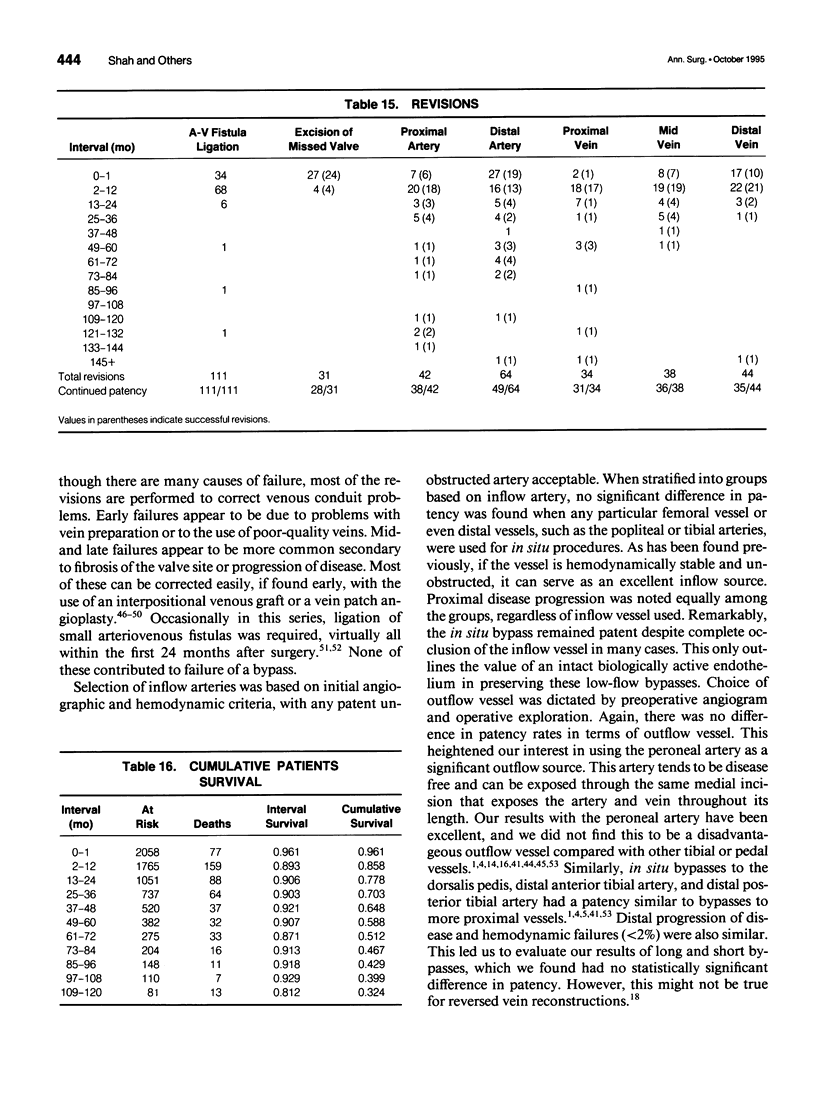
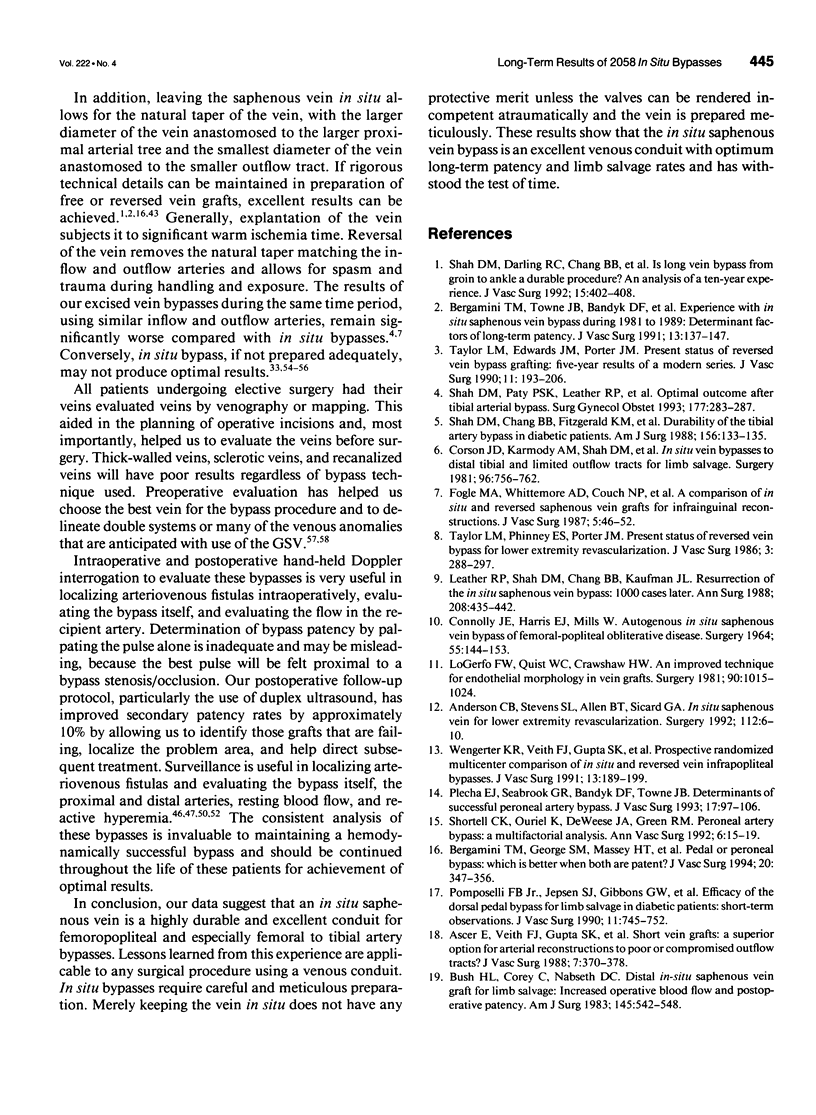
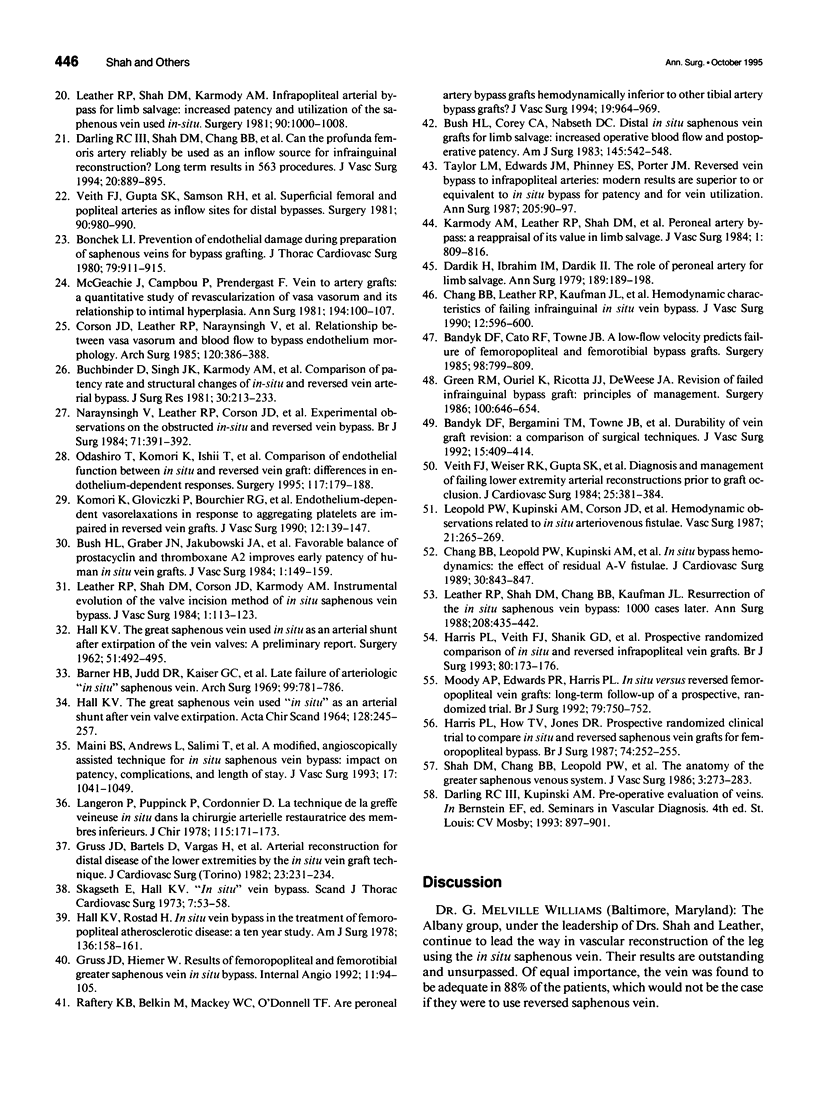
Selected References
These references are in PubMed. This may not be the complete list of references from this article.
- Anderson C. B., Stevens S. L., Allen B. T., Sicard G. A. In situ saphenous vein for lower extremity revascularization. Surgery. 1992 Jul;112(1):6–10. [PubMed] [Google Scholar]
- Ascer E., Veith F. J., Gupta S. K., White S. A., Bakal C. W., Wengerter K., Sprayregen S. Short vein grafts: a superior option for arterial reconstructions to poor or compromised outflow tracts? J Vasc Surg. 1988 Feb;7(2):370–378. doi: 10.1067/mva.1988.avs0070370. [DOI] [PubMed] [Google Scholar]
- Bandyk D. F., Cato R. F., Towne J. B. A low flow velocity predicts failure of femoropopliteal and femorotibial bypass grafts. Surgery. 1985 Oct;98(4):799–809. [PubMed] [Google Scholar]
- Barner H. B., Judd D. R., Kaiser G. C., Willman V. L., Hanlon C. R. Late failure of arterialized in situ saphenous vein. Arch Surg. 1969 Dec;99(6):781–786. doi: 10.1001/archsurg.1969.01340180105021. [DOI] [PubMed] [Google Scholar]
- Bergamini T. M., George S. M., Jr, Massey H. T., Henke P. K., Klamer T. W., Lambert G. E., Jr, Banis J. C., Jr, Miller F. B., Garrison R. N., Richardson J. D. Pedal or peroneal bypass: which is better when both are patent? J Vasc Surg. 1994 Sep;20(3):347–356. doi: 10.1016/0741-5214(94)90132-5. [DOI] [PubMed] [Google Scholar]
- Bergamini T. M., Towne J. B., Bandyk D. F., Seabrook G. R., Schmitt D. D. Experience with in situ saphenous vein bypasses during 1981 to 1989: determinant factors of long-term patency. J Vasc Surg. 1991 Jan;13(1):137–149. doi: 10.1067/mva.1991.25812. [DOI] [PubMed] [Google Scholar]
- Bonchek L. I. Prevention of endothelial damage during preparation of saphenous veins for bypass grafting. J Thorac Cardiovasc Surg. 1980 Jun;79(6):911–915. [PubMed] [Google Scholar]
- Buchbinder D., Singh J. K., Karmody A. M., Leather R. P., Shah D. M. Resident research award. Comparison of patency rate and structural changes of in situ and reversed vein arterial bypass. J Surg Res. 1981 Mar;30(3):213–222. doi: 10.1016/0022-4804(81)90150-5. [DOI] [PubMed] [Google Scholar]
- Bush H. L., Jr, Corey C. A., Nabseth D. C. Distal in situ saphenous vein grafts for limb salvage. Increased operative blood flow and postoperative patency. Am J Surg. 1983 Apr;145(4):542–548. doi: 10.1016/0002-9610(83)90055-7. [DOI] [PubMed] [Google Scholar]
- Bush H. L., Jr, Corey C. A., Nabseth D. C. Distal in situ saphenous vein grafts for limb salvage. Increased operative blood flow and postoperative patency. Am J Surg. 1983 Apr;145(4):542–548. doi: 10.1016/0002-9610(83)90055-7. [DOI] [PubMed] [Google Scholar]
- Bush H. L., Jr, Graber J. N., Jakubowski J. A., Hong S. L., McCabe M., Deykin D., Nabseth D. C. Favorable balance of prostacyclin and thromboxane A2 improves early patency of human in situ vein grafts. J Vasc Surg. 1984 Jan;1(1):149–159. [PubMed] [Google Scholar]
- CONNOLLY J. E., HARRIS E. J., MILLS W., Jr AUTOGENOUS IN SITU SAPHENOUS VEIN FOR BYPASS OF FEMORAL-POPLITEAL OBLITERATIVE DISEASE. Surgery. 1964 Jan;55:144–153. [PubMed] [Google Scholar]
- Chang B. B., Leather R. P., Kaufman J. L., Kupinski A. M., Leopold P. W., Shah D. M. Hemodynamic characteristics of failing infrainguinal in situ vein bypass. J Vasc Surg. 1990 Nov;12(5):596–600. [PubMed] [Google Scholar]
- Chang B. B., Leopold P. W., Kupinski A. M., Kaufman J. L., Leather R. P., Shah D. M. In situ bypass hemodynamics. The effect of residual A-V fistulae. J Cardiovasc Surg (Torino) 1989 Sep-Oct;30(5):843–847. [PubMed] [Google Scholar]
- Corson J. D., Karmody A. M., Shah D. M., Naraynsingh V., Young H. L., Leather R. P. In situ vein bypasses to distal tibial and limited outflow tracts for limb salvage. Surgery. 1984 Oct;96(4):756–763. [PubMed] [Google Scholar]
- Corson J. D., Leather R. P., Balko A., Naraynsingh V., Karmody A. M., Shah D. M. Relationship between vasa vasorum and blood flow to vein bypass endothelial morphology. Arch Surg. 1985 Mar;120(3):386–388. doi: 10.1001/archsurg.1985.01390270124022. [DOI] [PubMed] [Google Scholar]
- Dardik H., Ibrahim I. M., Dardik I. I. The role of the peroneal artery for limb salvage. Ann Surg. 1979 Feb;189(2):189–198. doi: 10.1097/00000658-197902000-00010. [DOI] [PMC free article] [PubMed] [Google Scholar]
- Darling R. C., 3rd, Shah D. M., Change B. B., Lloyd W. E., Leather R. P. Can the deep femoral artery be used reliably as an inflow source for infrainguinal reconstruction? Long-term results in 563 procedures. J Vasc Surg. 1994 Dec;20(6):889–895. doi: 10.1016/0741-5214(94)90225-9. [DOI] [PubMed] [Google Scholar]
- Fogle M. A., Whittemore A. D., Couch N. P., Mannick J. A. A comparison of in situ and reversed saphenous vein grafts for infrainguinal reconstruction. J Vasc Surg. 1987 Jan;5(1):46–52. [PubMed] [Google Scholar]
- Green R. M., Ouriel K., Ricotta J. J., DeWeese J. A. Revision of failed infrainguinal bypass graft: principles of management. Surgery. 1986 Oct;100(4):646–654. [PubMed] [Google Scholar]
- Gruss J. D., Bartels D., Vargas H., Karadedos C., Schlechtweg B. Arterial reconstruction for distal disease of the lower extremities by the in situ vein graft technique. J Cardiovasc Surg (Torino) 1982 May-Jun;23(3):231–234. [PubMed] [Google Scholar]
- Gruss J. D., Hiemer W. Results of femoropopliteal and femorotibial greater saphenous vein in situ bypass. Life table analysis. Int Angiol. 1992 Apr-Jun;11(2):94–105. [PubMed] [Google Scholar]
- HALL K. V., HILLESTAD L. K. THE GREAT SAPHENOUS VEIN USED IN SITU AS AN ARTERIAL SHUNT AFTER VEIN VALVE EXTIRPATION. AN EVALUATION OF ITS PROPERTIES OF RESTORING THE CIRCULATION THROUGH DISEASED LIMBS AS COMPARED TO OTHER RECONSTRUCTIVE METHODS. Acta Chir Scand. 1964 Sep;128:245–251. [PubMed] [Google Scholar]
- HALL K. V. The great saphenous vein used in situ as an arterial shunt after extirpation of the vein valves. A preliminary report. Surgery. 1962 Apr;51:492–495. [PubMed] [Google Scholar]
- Hall K. V., Rostad H. David M. Hume memorial lecture. In situ vein bypass in the treatment of femoropopliteal atherosclerotic disease: a ten year study. Am J Surg. 1978 Aug;136(2):158–161. doi: 10.1016/0002-9610(78)90217-9. [DOI] [PubMed] [Google Scholar]
- Harrington E. B., Harrington M. E., Schanzer H., Jacobson J. H., Haimov M. The dorsalis pedis bypass--moderate success in difficult situations. J Vasc Surg. 1992 Feb;15(2):409–416. doi: 10.1067/mva.1992.33161. [DOI] [PubMed] [Google Scholar]
- Harris P. L., How T. V., Jones D. R. Prospectively randomized clinical trial to compare in situ and reversed saphenous vein grafts for femoropopliteal bypass. Br J Surg. 1987 Apr;74(4):252–255. doi: 10.1002/bjs.1800740409. [DOI] [PubMed] [Google Scholar]
- Harris P. L., Veith F. J., Shanik G. D., Nott D., Wengerter K. R., Moore D. J. Prospective randomized comparison of in situ and reversed infrapopliteal vein grafts. Br J Surg. 1993 Feb;80(2):173–176. doi: 10.1002/bjs.1800800213. [DOI] [PubMed] [Google Scholar]
- Karmody A. M., Leather R. P., Shah D. M., Corson J. D., Naraynsingh V. Peroneal artery bypass: a reappraisal of its value in limb salvage. J Vasc Surg. 1984 Nov;1(6):809–816. [PubMed] [Google Scholar]
- Komori K., Gloviczki P., Bourchier R. G., Miller V. M., Vanhoutte P. M. Endothelium-dependent vasorelaxations in response to aggregating platelets are impaired in reversed vein grafts. J Vasc Surg. 1990 Aug;12(2):139–147. doi: 10.1067/mva.1990.20925. [DOI] [PubMed] [Google Scholar]
- Langeron P., Puppinck P., Cordonnier D. La technique de la greffe veineuse "in situ" dans la chirurgie artérielle restauratrice des membres inférieurs. J Chir (Paris) 1978 Mar;115(3):171–173. [PubMed] [Google Scholar]
- Leather R. P., Shah D. M., Chang B. B., Kaufman J. L. Resurrection of the in situ saphenous vein bypass. 1000 cases later. Ann Surg. 1988 Oct;208(4):435–442. doi: 10.1097/00000658-198810000-00005. [DOI] [PMC free article] [PubMed] [Google Scholar]
- Leather R. P., Shah D. M., Chang B. B., Kaufman J. L. Resurrection of the in situ saphenous vein bypass. 1000 cases later. Ann Surg. 1988 Oct;208(4):435–442. doi: 10.1097/00000658-198810000-00005. [DOI] [PMC free article] [PubMed] [Google Scholar]
- Leather R. P., Shah D. M., Corson J. D., Karmody A. M. Instrumental evolution of the valve incision method of in situ saphenous vein bypass. J Vasc Surg. 1984 Jan;1(1):113–123. doi: 10.1067/mva.1984.avs0010113. [DOI] [PubMed] [Google Scholar]
- Leather R. P., Shan D. M., Karmody A. M. Infrapopliteal arterial bypass for limb salvage: increased patency and utilization of the saphenous vein used "in situ". Surgery. 1981 Dec;90(6):1000–1008. [PubMed] [Google Scholar]
- LoGerfo F. W., Quist W. C., Crawshaw H. M., Haudenschild C. An improved technique for preservation of endothelial morphology in vein grafts. Surgery. 1981 Dec;90(6):1015–1024. [PubMed] [Google Scholar]
- Maini B. S., Andrews L., Salimi T., Hendershott T. H., O'Mara P. A modified, angioscopically assisted technique for in situ saphenous vein bypass: impact on patency, complications, and length of stay. J Vasc Surg. 1993 Jun;17(6):1041–1049. [PubMed] [Google Scholar]
- McGeachie J., Campbell P., Prendergast F. Vein to artery grafts. A quantitative study of revascularization by vasa vasorum and its relationship to intimal hyperplasia. Ann Surg. 1981 Jul;194(1):100–107. doi: 10.1097/00000658-198107000-00018. [DOI] [PMC free article] [PubMed] [Google Scholar]
- Moody A. P., Edwards P. R., Harris P. L. In situ versus reversed femoropopliteal vein grafts: long-term follow-up of a prospective, randomized trial. Br J Surg. 1992 Aug;79(8):750–752. doi: 10.1002/bjs.1800790809. [DOI] [PubMed] [Google Scholar]
- Odashiro T., Komori K., Ishii T., Okadome K., Sugimachi K. Comparison of endothelial function between in situ and reversed vein graft: differences in endothelium-dependent responses. Surgery. 1995 Feb;117(2):179–188. doi: 10.1016/s0039-6060(05)80083-2. [DOI] [PubMed] [Google Scholar]
- Plecha E. J., Seabrook G. R., Bandyk D. F., Towne J. B. Determinants of successful peroneal artery bypass. J Vasc Surg. 1993 Jan;17(1):97–106. doi: 10.1067/mva.1993.41753. [DOI] [PubMed] [Google Scholar]
- Pomposelli F. B., Jr, Jepsen S. J., Gibbons G. W., Campbell D. R., Freeman D. V., Miller A., LoGerfo F. W. Efficacy of the dorsal pedal bypass for limb salvage in diabetic patients: short-term observations. J Vasc Surg. 1990 Jun;11(6):745–752. doi: 10.1067/mva.1990.19884. [DOI] [PubMed] [Google Scholar]
- Raftery K. B., Belkin M., Mackey W. C., O'Donnell T. F. Are peroneal artery bypass grafts hemodynamically inferior to other tibial artery bypass grafts? J Vasc Surg. 1994 Jun;19(6):964–969. doi: 10.1016/s0741-5214(94)70207-1. [DOI] [PubMed] [Google Scholar]
- Shah D. M., Chang B. B., Fitzgerald K. M., Kaufman J. L., Leather R. P. Durability of the tibial artery bypass in diabetic patients. Am J Surg. 1988 Aug;156(2):133–135. doi: 10.1016/s0002-9610(88)80373-8. [DOI] [PubMed] [Google Scholar]
- Shah D. M., Chang B. B., Leopold P. W., Corson J. D., Leather R. P., Karmody A. M. The anatomy of the greater saphenous venous system. J Vasc Surg. 1986 Feb;3(2):273–283. [PubMed] [Google Scholar]
- Shah D. M., Darling R. C., 3rd, Chang B. B., Kaufman J. L., Fitzgerald K. M., Leather R. P. Is long vein bypass from groin to ankle a durable procedure? An analysis of a ten-year experience. J Vasc Surg. 1992 Feb;15(2):402–408. [PubMed] [Google Scholar]
- Shah D. M., Paty P. S., Leather R. P., Chang B. B., Darling R. C., 3rd, Feustel P. J. Optimal outcome after tibial arterial bypass. Surg Gynecol Obstet. 1993 Sep;177(3):283–287. [PubMed] [Google Scholar]
- Shortell C. K., Ouriel K., DeWeese J. A., Green R. M. Peroneal artery bypass: a multifactorial analysis. Ann Vasc Surg. 1992 Jan;6(1):15–19. doi: 10.1007/BF02000661. [DOI] [PubMed] [Google Scholar]
- Skagseth E., Hall K. V. In situ vein bypass. Experiences with new vein valve strippers. Scand J Thorac Cardiovasc Surg. 1973;7(1):53–58. doi: 10.3109/14017437309139167. [DOI] [PubMed] [Google Scholar]
- Taylor L. M., Jr, Edwards J. M., Phinney E. S., Porter J. M. Reversed vein bypass to infrapopliteal arteries. Modern results are superior to or equivalent to in-situ bypass for patency and for vein utilization. Ann Surg. 1987 Jan;205(1):90–97. doi: 10.1097/00000658-198701000-00017. [DOI] [PMC free article] [PubMed] [Google Scholar]
- Taylor L. M., Jr, Edwards J. M., Porter J. M. Present status of reversed vein bypass grafting: five-year results of a modern series. J Vasc Surg. 1990 Feb;11(2):193–206. doi: 10.1067/mva.1990.17235. [DOI] [PubMed] [Google Scholar]
- Taylor L. M., Jr, Phinney E. S., Porter J. M. Present status of reversed vein bypass for lower extremity revascularization. J Vasc Surg. 1986 Feb;3(2):288–297. [PubMed] [Google Scholar]
- Veith F. J., Gupta S. K., Samson R. H., Flores S. W., Janko G., Scher L. A. Superficial femoral and popliteal arteries as inflow sites for distal bypasses. Surgery. 1981 Dec;90(6):980–990. [PubMed] [Google Scholar]
- Veith F. J., Weiser R. K., Gupta S. K., Ascer E., Scher L. A., Samson R. H., White-Flores S. A., Sprayregen S. Diagnosis and management of failing lower extremity arterial reconstructions prior to graft occlusion. J Cardiovasc Surg (Torino) 1984 Sep-Oct;25(5):381–384. [PubMed] [Google Scholar]
- Wengerter K. R., Veith F. J., Gupta S. K., Goldsmith J., Farrell E., Harris P. L., Moore D., Shanik G. Prospective randomized multicenter comparison of in situ and reversed vein infrapopliteal bypasses. J Vasc Surg. 1991 Feb;13(2):189–199. [PubMed] [Google Scholar]


